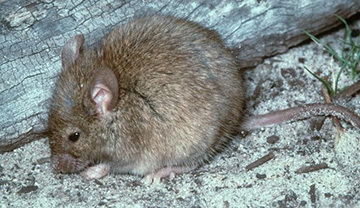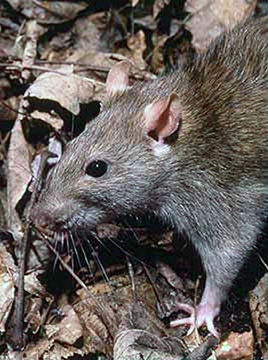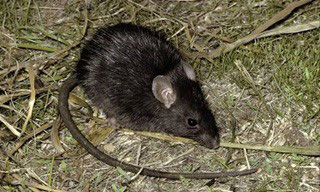Winter's cold, wet and windy days are upon us and it's a great comfort returning to our warm, dry Sanctuary Lakes residences. With the exception of humans, the planet’s most successful species also has a hankering for a little warm dry comfort and is quite happy to "bunk up" with humans. I am of course referring to our often-unwelcomed winter guests the Rodents. The three most likely of these pesky mammals to be seen in Sanctuary Lakes are the House Mouse, Norwegian Brown Rat and the Ship or Black Rat. The warm wet spring and summer has meant there appears to be an increase in their population, not a plague fortunately, but they can be seen during the daylight hours which is very uncommon. These three are Old World species and arrived with the very first European settlers and within a short time established themselves over most of the continent, following the pioneer's settlements and thriving where humans live.
 Common house mouse (Mus musculus) The House Mouse a relatively small 70 - 95mm in length, with a tail around the same length and weighing 15-30g. Small feet and head, with large eyes and rounded ears, brownish-grey 7mm long, soft dense fur above, white to grey below, quickly distinguishing them from other similar small rodents. Their ability to live on a wide range of foodstuffs, including most of those eaten by man, and their ability to adapt to a wide variety of environmental conditions has earned mice the unenviable reputation of being a pest.
Common house mouse (Mus musculus) The House Mouse a relatively small 70 - 95mm in length, with a tail around the same length and weighing 15-30g. Small feet and head, with large eyes and rounded ears, brownish-grey 7mm long, soft dense fur above, white to grey below, quickly distinguishing them from other similar small rodents. Their ability to live on a wide range of foodstuffs, including most of those eaten by man, and their ability to adapt to a wide variety of environmental conditions has earned mice the unenviable reputation of being a pest.
With cold wet winter days, it is difficult to keep mice out of buildings because of their ability to swim, dig, jump up to at least 300 mm, jump down at least 2.5 metres without injury, and squeeze through openings as small as 8 mm wide. In addition, they can run up most rough surfaces, run down ropes and electric wires, and climb upside down along wire mesh.
Mice have a relatively short life span of between 12 to 15 months, but it takes a mouse only six weeks to reach maturity and their gestation period is about 19 to 21 days. They even get pregnant as soon as they've given birth, so they're gestating a new litter while weaning their current one. To put that in perspective, a single breeding pair of mice could produce up to 500 offspring in a breeding season (spring to summer). In reality, they can in a good breeding year, produce half that number.
 The Norway Rat Rattus Norvegicus It is generally agreed that the Norway Rat did not originate in Norway. It is believed to have travelled from Persia to England less than two hundred years ago and then rapidly spread to other countries and continents hitching a ride on English ships.
The Norway Rat Rattus Norvegicus It is generally agreed that the Norway Rat did not originate in Norway. It is believed to have travelled from Persia to England less than two hundred years ago and then rapidly spread to other countries and continents hitching a ride on English ships.
Norway rats are large rodents that may weigh in excess of 500 grams. They can reach lengths of 40 cm, and their tails alone may measure 21 cm. The ears and tail are scaled and their body is covered in shaggy fur that is brown or grey in colour.
Norway rats thrive in a variety of human habitats. While it is believed that they originally lived only within temperate forest regions, they are extremely adaptive and now thrive comfortably in densely populated cities. In our area, they typically nest in underground burrows and then nocturnally enter our habitat in search of food. The new sub-divisions around Sanctuary Lakes have disturbed their usual routine although they still tend to remain in hiding during the day they may be seen early evening or morning scampering around searching for food. As a true omnivore, they will consume almost anything, but cereals and grass grains form a substantial part of their diet.
The Norway rat reaches sexual maturity in two to five months and can breed any month of the year. Litters may number from four to 22. Females can have three to 12 litters per year. Adults generally live up to one year in the wild.
 The Black Rat or Ship Rat, Rattus rattus The Black Rat is also known as the Ships Rat or Roof Rat. Easily recognised by its slender body and long tail (average length 230 mm), which is much longer than the length of the head and body (total average length 190 mm), and by its large, thin pink ears. The sleek coat on the rat's back may vary from black to light brown. The underbelly is usually pale grey-white. Like other species of rodents, the Black Rat has yellow to orange incisor teeth.
The Black Rat or Ship Rat, Rattus rattus The Black Rat is also known as the Ships Rat or Roof Rat. Easily recognised by its slender body and long tail (average length 230 mm), which is much longer than the length of the head and body (total average length 190 mm), and by its large, thin pink ears. The sleek coat on the rat's back may vary from black to light brown. The underbelly is usually pale grey-white. Like other species of rodents, the Black Rat has yellow to orange incisor teeth.
It is an excellent climber and in its natural habitat is a tree-dweller. When living inside a building, it will nest in roofs or in cavities above the ceiling. Sometimes in holes in the wall or beneath the floorboards.
Black Rats are nocturnal and they tend to forage after sunset. If the food cannot be eaten quickly, they will search for a place to carry and hoard to eat at a later time. Seeing these tell-tale scraps often is a guide to knowing a Black Rat is in the vicinity.
They are social animals, living in groups consisting of a dominant male and several adult females with their offspring, defending their group territory against other groups.
After a gestation period of 21 days, the female gives birth to usually a 5-7 litter. Under favourable conditions reproduction is not seasonal, and a female may have 3-5 litters in one year. In the wild the Black Rat's lifespan is hardly more than twelve months.
Our unwanted guests do have predators, specifically Cats, particularly the feral kind. Also, Foxes and Snakes enjoy rodent dinners. From above Owls and Hawks. And last week on the Golf Course's 7th fairway I saw a House Mouse in the beak of a Flute Magpie!
Unfortunately, the predators only make a dent in the rodent population and with the winter weather upon us, the warmth and food source of our cosy homes are very tempting for our rodent guests. Here are a few basic tips to Rodent Proof your home:
- Seal all openings around pipes, cables, and wires that enter through walls or the foundation. (Steel Wool is a recommended quick temporary sealer)
- Be sure all windows that can be opened are screened and that the screens are in good condition
- Make sure all exterior doors are tight fitting and weatherproofed at the bottom
- Seal gaps beneath garage doors with a gasket or weather-stripping
- Keep side doors to the garage closed, especially at night
All rodents are very clever at hiding from humans, so any signs like droppings or food scraps, contact the council’s rodent catcher immediately. Remember rodents can produce litters within 20 days and that can make a great deal of nuisance in your home.